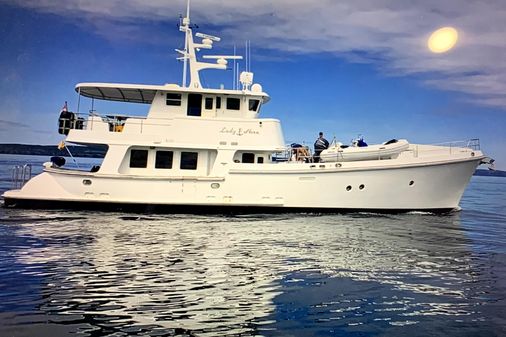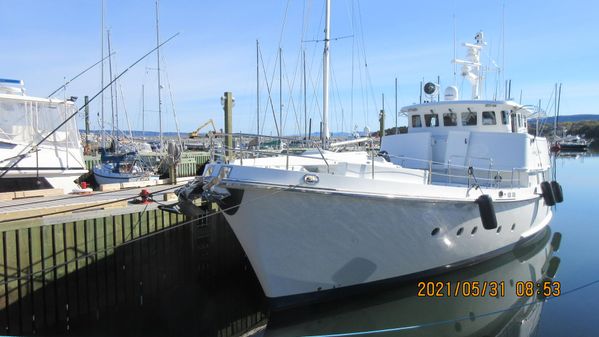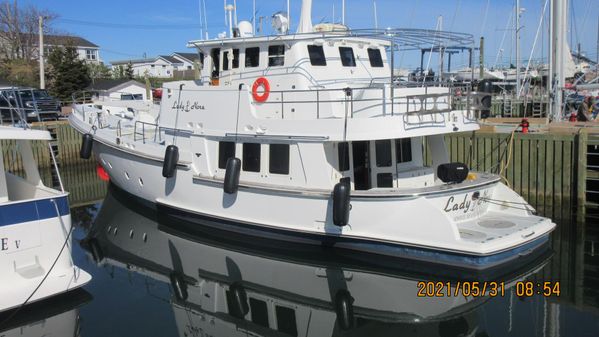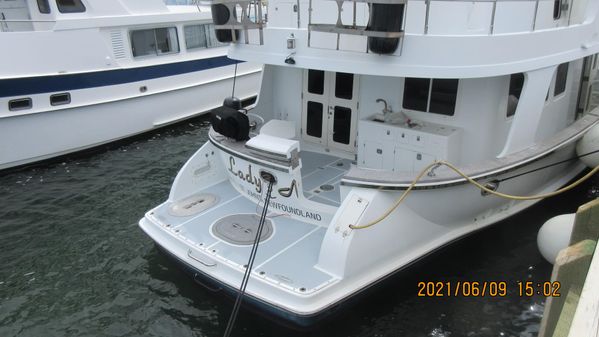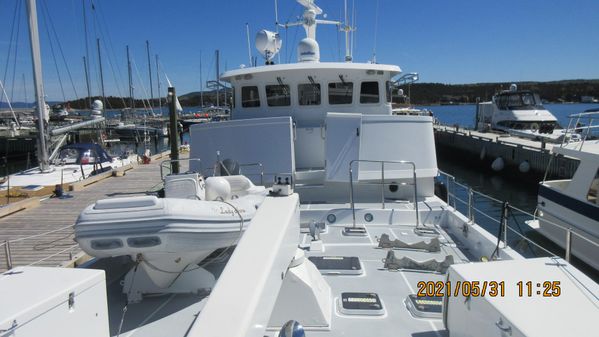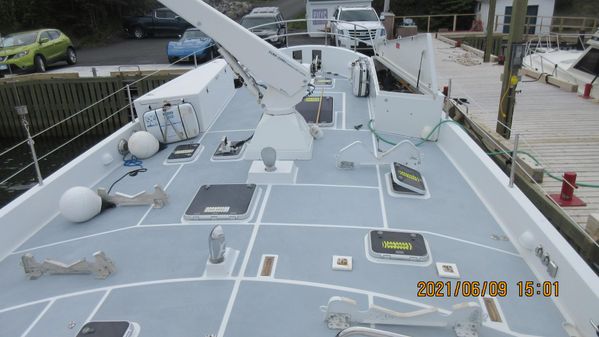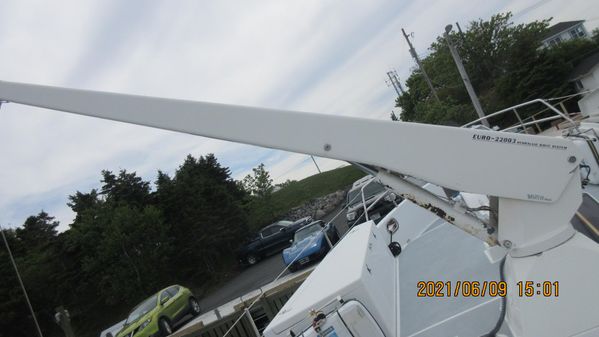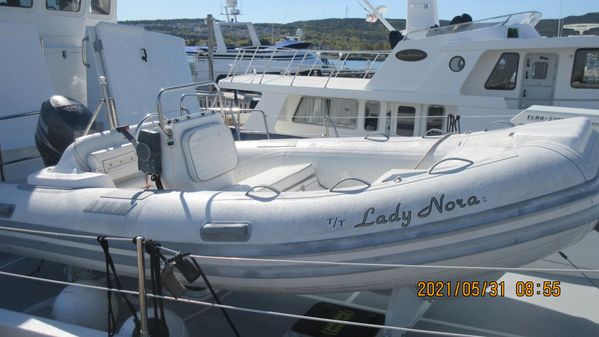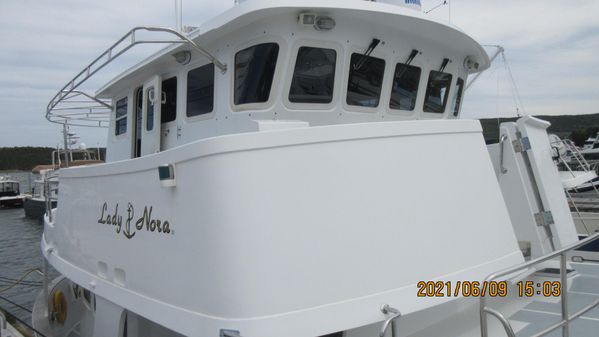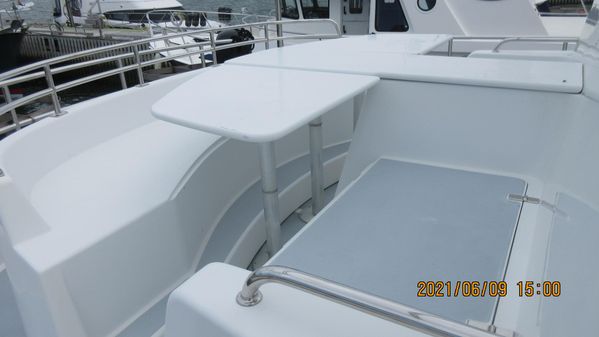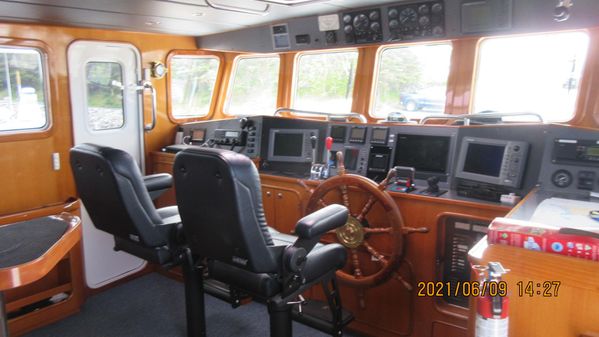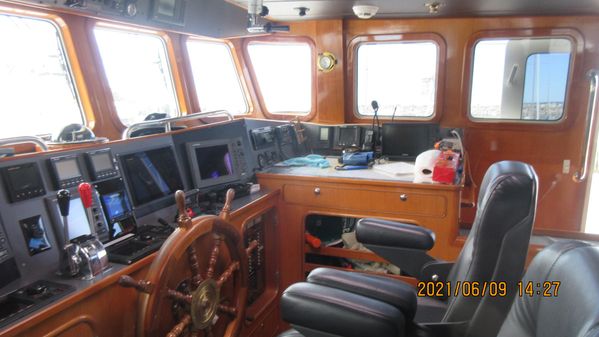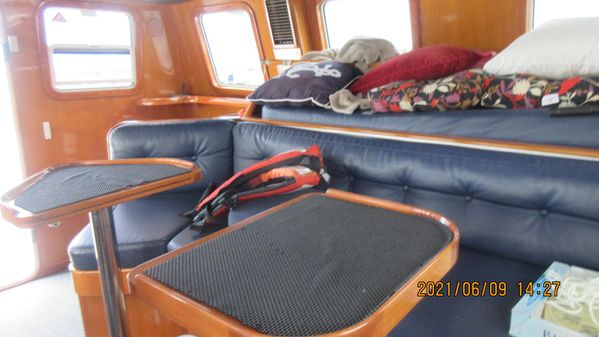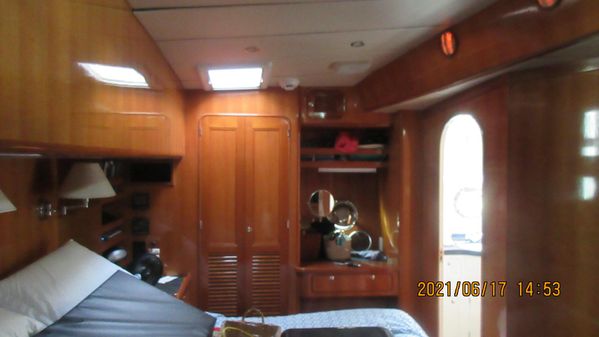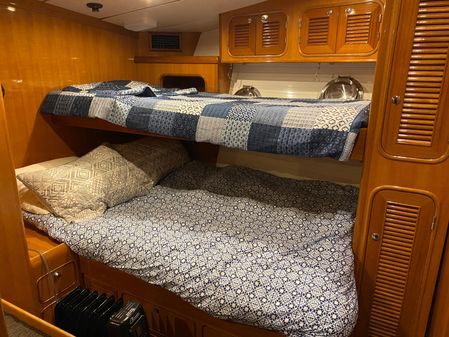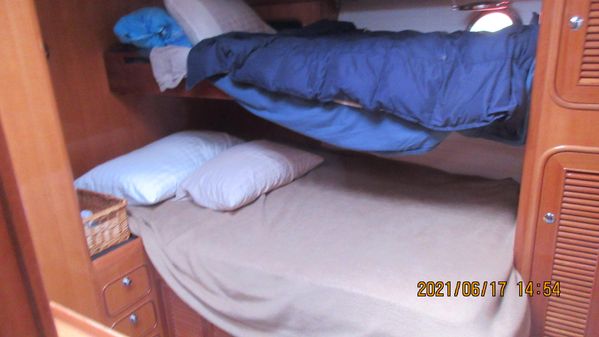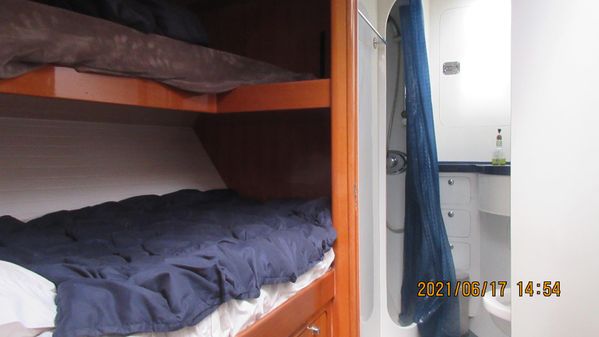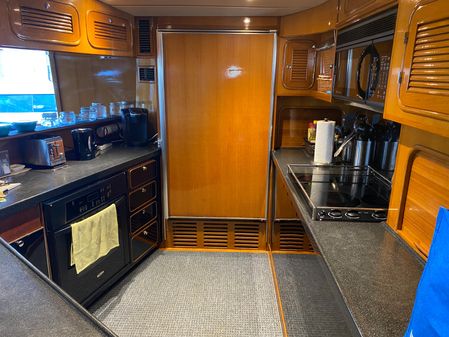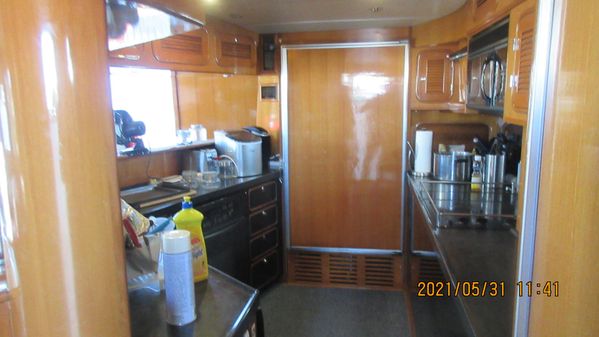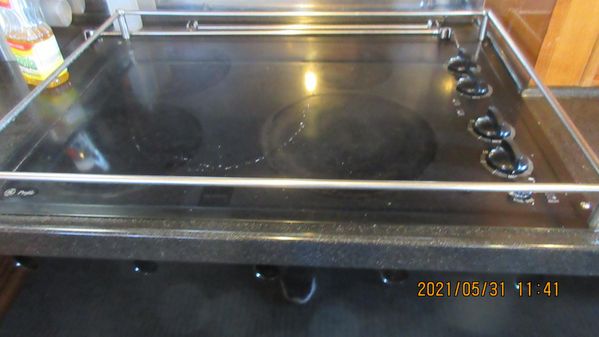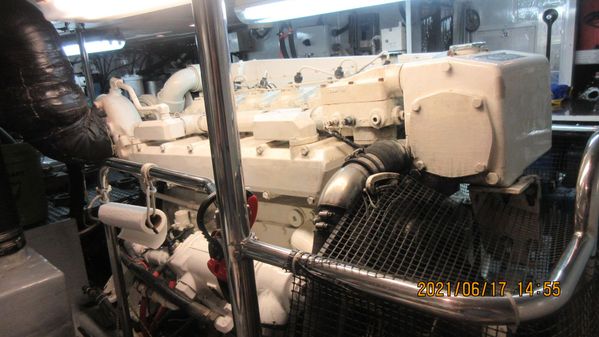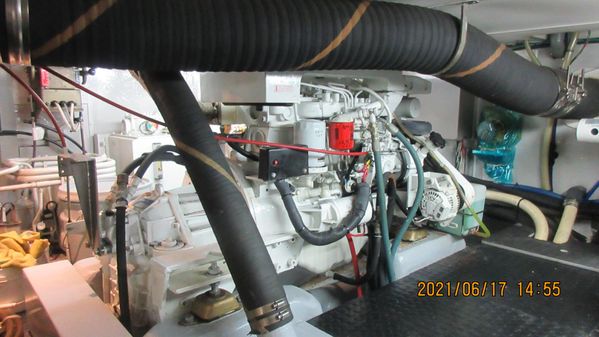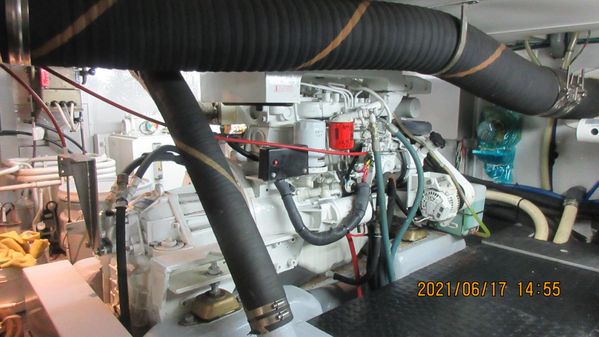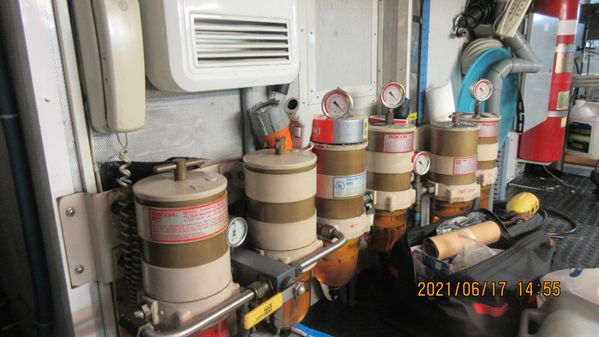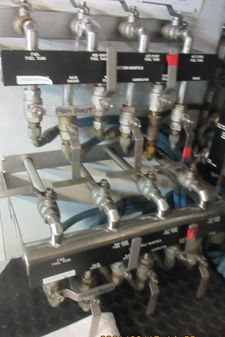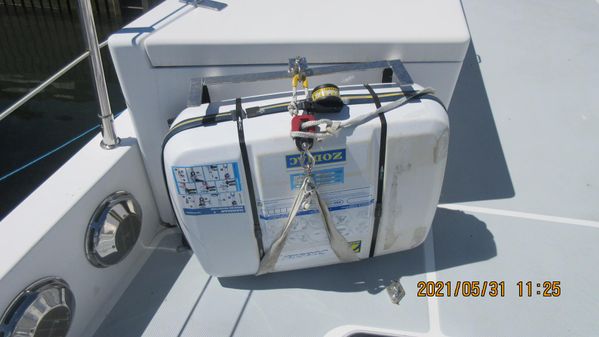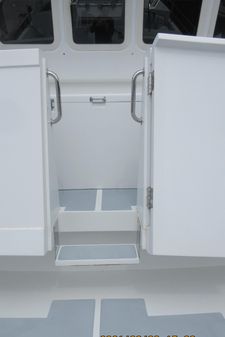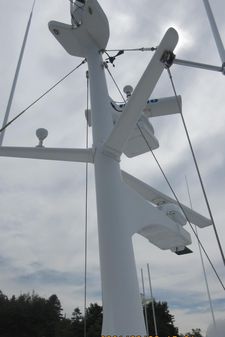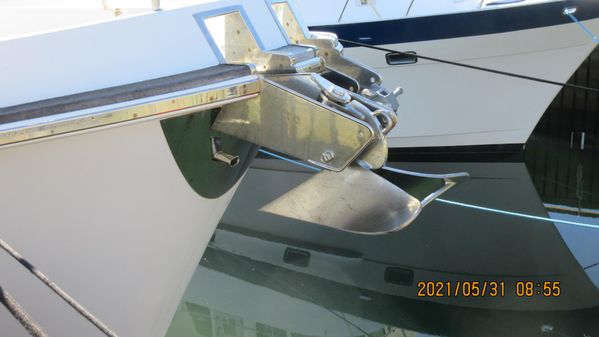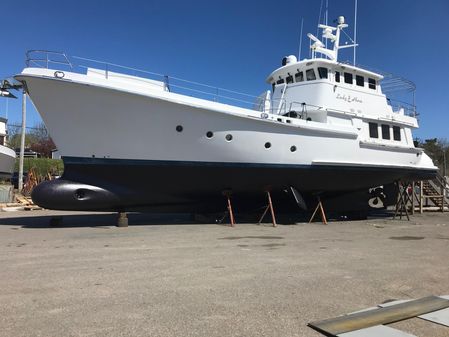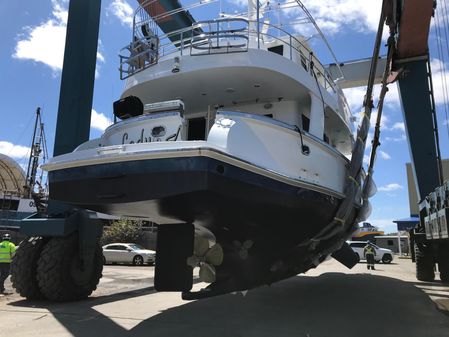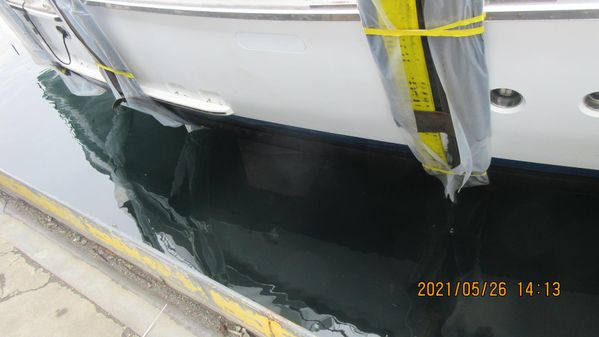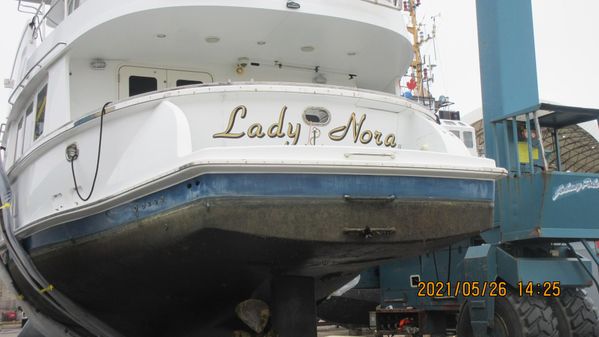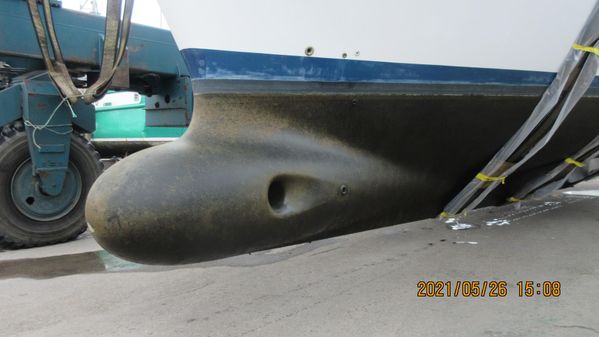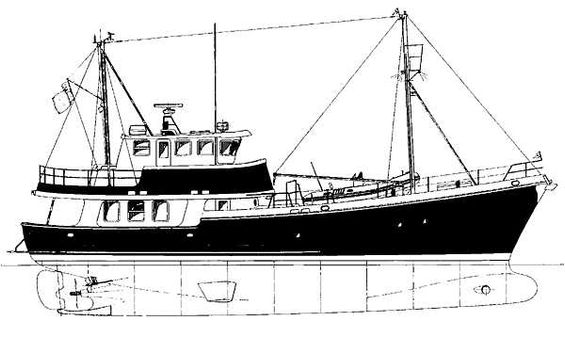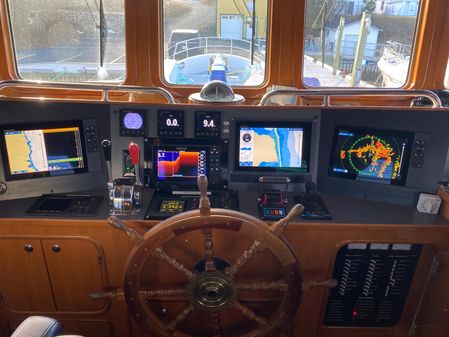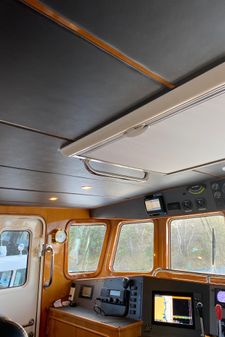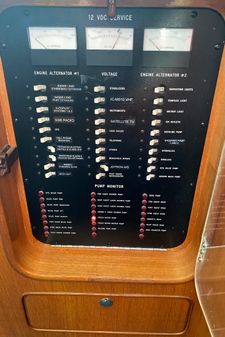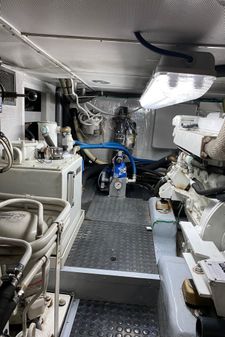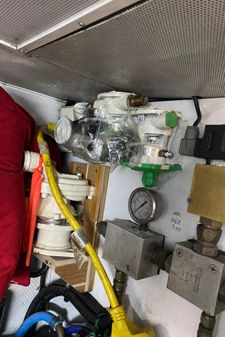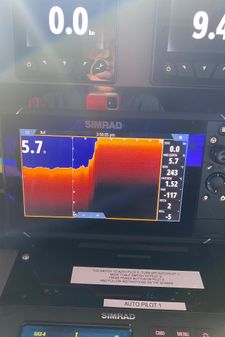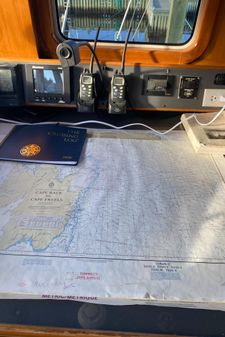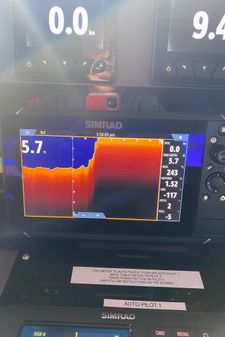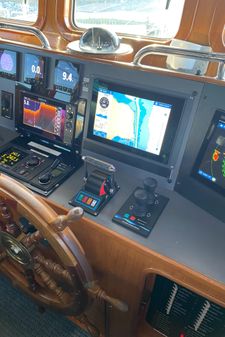Basic Boat Info
Dimensions
Engines / Speed
- Make: Lugger
- Model: L6125A
- Fuel: Diesel
- Engine Power: 325hp
- Type: Inboard
- Engine Location: Center
- Year: 1999
- Engine Hours: 7,900
Tanks
Other
Contact
Office
130 Marina Rd, Suite 202
CHESTER, NS, CA, B0J 1J0
Tel:902 444 4500
The Company offers the details of this vessel in good faith but cannot guarantee or warrant the accuracy of this information nor warrant the condition of the vessel. A buyer should instruct his agents, or his surveyors, to investigate such details as the buyer desires validated. This vessel is offered subject to prior sale, price change, or withdrawal without notice.
Entry in the salon is from the aft deck through double water tight doors.
Forward of the salon is the galley.
OVERVIEW
Water tight entry door to starboard. Steps up to pilothouse.
Forward of the galley is a teak & holly soled companionway leading to the engine room and forward with the Master stateroom.
Master stateroom has an ensuite head.
Also forward are the laundry, a guest stateroom with ensuite head to port and a guest stateroom to starboard plus day head.
Forward most is the guest/crew cabin with ensuite head.
All cabin areas have bound carpeting, halogen lighting, reading lights and intercom system. The yacht is fitted with seven (7) CruiseAir reverse cycle air/heat systems ranging from 6,000 to 16,000BTU's.
All heads have Corian countertops, full showers and Vacuflush heads.
MAIN SALON
The main salon features a large setter and dining table with leaf on the starboard side. To port is the entertainment area and two reclining chairs. The salon features custom mini blinds, KVH Trac Vision 6 to Panasonic TV with VHS and DVD along with a Bose surround sound system.
GALLEY
The galley has a teak and holly cabin sole and is equipped with a Whirlpool oven/broiler, Whirlpool four burner stove, Whirlpool convection/micorwave and Kenmore dishwasher. There is a SubZero refrigerator along with a SubZero freezer/icemaker. Brian trash compactor, Garburator(not working) in sink. The Asko washing machine and Miele dryer are located in the companionway area.
MASTER STATEROOM
The amidships port side master stateroom includes a king sized centreline berth with night stands on both sides. Generous storage in the cabin in hanging lockers, cabinets, drawers and bookshelves. Vanity located on the portside. Ensuite head has full standup shower. There is a port light plus two opening hatches and a Panasonic TV system.
PORT GUEST STATEROOM
This guest stateroom is located forward and amidships. Accommodations include a couple berth and a single upper bunk. Full ensuite head with standup shower. There is a opening hatch, two port lights and considerable storage.
STARBOARD GUEST STATEROOM
This guest stateroom is located forward and amidships. Accommodations include lower and upper bunks. Full ensuite head with standup shower which also serves as there day head. There is a opening hatch and considerable storage.
GUEST/CREW STATEROOM
Forward guest or crew cabin with ensuite head. Accommodations include a double berth with upper single bunk. Full ensuite head with standup shower. There is a watertight door, opening hatch, considerable storage plus a Panasonic TV system.
The pilothouse has a virtually 360 degree panoramic vie with a large seating area and dining table.
There is a separate navigation/computer desk and a full array of electronics with many of them duplicated. Practical layout offering an owner/skipper ease of use and comfort during offshore passages.
Opening windows(2) and hatches(3) allow for natural ventilation in addition to two watertight doors. There is a freezer located beneath the pilot berth.
Electronics include;
- Furuno radar x 2(new 2022)
- Simrad autopilot x 2(new 2018)
- Furuno 12" GPS plotter
- Garmin 12' GPS Plotter
- Furuno GPS GP-150
- VHF x 2(new in 2022)
- VHF x 2 - handheld
- ICOM 700 SSB radio
- Furuno Sonar(new in 2022)
- B&G Depthfinder(new in 2022)
- B&G Wind, Log, Depth
- Rudder angle indictaor
- Iridium Satellite telephone
- Globalstar Satellite telephone
- Mini M Worldfone voice and date
- Robertson FU35 Steering Lever(for outside bridge stations)
- Dual Speed Autopilot Pumps
- McMurdo G5 EPIRB
- AIS
- Weems & Plath Barometer
- Wempe Barometer
- Wempe Clock
- Danforth Compass
- Pioneer Stereo System w/cabin & exterior speakers
Additional items in the pilothouse include;
- Stidd series 500 helm seats (2)
- Spot light control(new spotlight in 2022)
- Oregon Scientific Weather Station
- Dual Trumpet Horn
- Norcold Refrigerator
MAIN ENGINE
The Lugger L6125A main engine w/@7,900hrs use; 325hp 6 cyliner cooled via a Walter Keel Cooler. The 3" s/s shaft has a PPS dripless seal. Propellor is a 41" 4 blade Hung Shen.
WING ENGINE
The Lugger L9840 wing engine w/@1,300 hrs use; fresh water cooled; three blade feathering MaxProp on a 1 1/8" s/s shaft.
ENGINE ROOM & MANEUVERING EQUIPMENT
The engine room includes;
- bow thruster (new 2018)
- stern thruster (new 2018)
- Naiad Stabilizer 252 w/digital Multisea 2000
- Sea Recovery Watermaker, 53Gal/Hr
- CruiseAir Reverse Cycle Air Conditioning System
- DeVilbiss Air Compressor 1.5hp; 125psi
- Electrolux central vac system
- Sealand Vacuflush sanitation system
- Electric water heater 30 Gal
- Sony TV surveillance system
- Edson manual bilge pumps (3)
- Jabsco electric bilge pumps (all compartments)
- Hydraulic self priming Centrifugal Pacer Pumps (2)
- Flowscan monitor for fuel consumption
- Racor filters (6)
- Halon Fire Buoy Extinguishing System (2)
ELECTRCIAL
- two Marino 50amp 120/240v shore power inlets
- Northern Lights 20Kw Generator w/@6,000hrs (new in 2007)
- 15Kw Generator w/@1,200hrs (new in 2018)
- Trace Invertor/Chargers 2500w (2)
- 12v Batteries 8D for house (8) (new in 2018)
- 12v Batteries 4D for main engine (2) (new in 2018)
- 12v Battery 4D for 20Kw gen (new in 2018)
- 12v Battery for 15Kw gen (new in 2018)
- Sentry Battery Charger
Forward port and starboard bridge wing stations equipped with thruster controls, steering and engine controls.
Portuguese bridge with nonskid decks and 2500lb life capacity hydraulic crane.
FORWARD DECK
Equipment includes;
- Maxwell 3500 electric windlass with controls in Pilothouse and on Deck
- Nautical Structures Eurohydrualic deck crane(2500lb lift)
- Lewmar hatches (17)
- Dorades (3) for ventilation
- Washdown - fresh and sea water
- Freshwater connections, bow and stern
- Custom CQR type 200lb anchor with 175' of 5/8" chain
- Fortress Anchor
- Vetus s/s wipers (3)
- Hella deck floodlights (2)
- Caribe CL-16 Hard Bottom 16' Inflatable Tender with 60hp Yamaha Outboard w/cover
- Survitec SAS six man liferaft
- Zodiac Coastal six man life raft x 2
- Hydro static releases on all three life rafts
- Nico Day/Night solar powered vents (2)
- Gas Tank (40gal) with pump for Tender
- Stereo Speakers
- Deck boxes
- Six Fenders & Ducklings
AFT DECK
Aft deck area has space for seating, dining and access to swim platform with boarding ladder.
Covered upper aft deck has seating area with dining table.
Equipment includes;
- Backdown control station
- Maxwell electric two speed self tailing winch on aft deck
- Freeman hatch
- stereo speakers
- lazaretto for storage
The current owners of this Nordhavn 62 have enjoyed cruising her in the cold waters of Newfoundland to the warm southern waters of Florida since 2005.
In 2007 they replaced the main generator, added new radars, flatscreen TV with Satellite TC plus an SSB radio and a Mic-Com system.
In 2018 they did a significant refit in FL at Nordhavn's yard that included new bow and stern thrusters, new autopilots, new ceiling sin the main cabin and pilothouse with new lighting. They replaced the 12Kw secondary generator with a larger 15Kw generator. The stern tube was inspected, all valves and hoses were replaced. The topsides were buffed and waxed and new batteries were installed.
In 2022 they did another update which included new radars, new sonar, depth sounder, VHF's, 120v plugs swapped for new, two new air conditioning compressors, canvas, spotlight and added continuous Satellite TV system.
She is equipped with an extensive spares supply on board to make her as independent of shore side assistance as possible.
P.A.E. Yacht Builders, Inc. in Dana Point has built a solid reputation with the successful Mason series sailboats. The Nordhavn 62 is the product of the experience and expertise of P.A.E.'s designers as well as fine workmanship from our yards in the Orient. While design and construction details meet commercial specifications, the 62 features finish and styling that is a cut above. The interior layout lends itself to offshore voyaging and extended liveaboard use. While the buyer may customize the layout to suit individual needs, the standard configuration provides luxurious accommodations within three staterooms, maintaining two separate cabins for a captain and crew. The Asian yard doing the construction (Ta Shing Yacht Building Co.) has manufactured PAE's Mason sailboats (34 to 64 feet) and has established a reputation over the last fifteen years for producing some of the finest joiner work and finishes available anywhere in the world. Like the exterior glass work detailing, the interior of the 62 is spectacular. Satin varnished teak paneling and trim sets the tone of the ship's interior, with some Formica paneling used within the staterooms due to reduced natural light. A wide selection of alternate woods is available (ash, cherry, oak, or mahogany), and high-gloss varnish can be substituted for the hand rubbed finish. Within the galley and head compartments, teak and spruce floors are provided with a buyer's choice of vinyls. Standard equipment includes: Sealand-Vacuflush toilets, Grohe galley and head fixtures, Corian countertops, large capacity bilge pumps, 2,000 amps of DC - 12-volt battery capacity, fuel transfer systems, Cruisair air conditioning, Sub Zero refrigeration systems, complete galley equipment, and washer - dryer. The Nordhavns are designed to appeal to an individual who, above all else, demands a proper ocean going yacht. Nordhavns have cruised extensively through the South Eastern Pacific from Hong Kong to California via Australia and Central America; as well, the 62 can cross the Atlantic, having passed from New York to Lisbon in less than 12 days (and with a reduction in speed a voyage from New York to Lisbon can be made, round trip, without taking on fuel). Of equal importance to her extended range, she displays a seakindly motion which results from the technically advanced displacement hull. A full-displacement hull was selected as the foundation of the 62's design. A planing hull does not run as efficiently as the displacement hull, and our requirement for a seakindly motion along with construction scantlings suitable for the most severe offshore conditions precluded the semidisplacement design. A heavy-displacement, round-bottomed hull with moderate initial stability and very high ultimate stability provides comfort in a seaway and is easily stabilized against roll - both underway and at anchor. Moderate draft and a long deep keel with an attached rudder insure excellent handling characteristics offshore, and a well-protected, slow turning propeller provides a great level of efficiency and security. The benefits of the bulbous bows of various configurations have been recognized world-wide by merchant ship designers. Unlike most yachts, the merchant ship is designed to run at a very constant speed and a low speed length ratio (a multiplier of the square root of the water line length). It is at specific speeds that the bow wave canceling bulb offers its greatest benefits. An additional benefit of the bulbous bow is the positive effect it can have on pitch dampening. The bulbous bow was tested in the BC Research Facility that has conducted extensive testing for the fishing fleets of Southeast Alaska and the Pacific Northwest. The results were very satisfying, showing a reduction in effective shaft horsepower of up to 12% at the upper ranges of cruising speed. A tremendous improvement in seakindliness resulted with a 20% reduction in pitch amplitude, an 18% reduction in pitch acceleration, and a 5% reduction in heave. The reduction in motion is primarily a result of the resistance of the horizontal surfaces of the bulb resisting vertical movement. This resistance is clearly seen because the effective horse power required is almost identical between the standard bow and the bulbous bow while running in the worst of head seas. It offered a reduction in horsepower required to run at our desired 9 to 10 knot cruising speed which would not only improve efficiency but also allow higher ocean crossing speeds with reduced noise and vibration. An improvement in hull efficiency of 10% should result in an increase of the true cruising speed by the same amount. Additionally, the motion of the vessel in a seaway is significantly improved by the bulbous bow. Roll is effectively eliminated by stabilizing gear but pitching can only be reduced by a change in speed or course. In an uncomfortable head sea, the bulb equipped hull will operate at the same efficiency as its standard bowed sister with a much more comfortable motion. Any vessel designed to cross oceans must adhere to the rule of the "above water below water ratio" which effectively states that too much superstructure and too little underbody adversely affects the vessel's ability to withstand adverse (and oftentimes unavoidable) open ocean conditions. However, the 62 is designed for the most rugged of conditions. The entire superstructure is located in the after half of the vessel and the foredeck is virtually flush. The high bow with substantial reserve buoyancy proves difficult to bury, and the forward portion of the superstructure is designed in anticipation of the worst conditions. The forward facing wheelhouse windows are protected by the Portuguese bridge combing, which is slanted forward and therefore not subject to perpendicular blasts of water. Additionally, the glass used is 12-mm (half-inch) thick. The aft location of the wheelhouse affords weather protection and reduced motion, allowing comfortable operation of the vessel in adverse conditions. The high bulwarks surrounding the aft and side decks, along with the Portuguese bridge, offer a high level of security for anyone moving around the vessel's exterior. Deck drains are provided to handle rain water and wash downs without a streaked hull. Large, slightly raised, flapped scuppers quickly release heavy water. The foredeck offers adequate space for two large tenders along with a hydraulic davit or hydraulically operated booms. All construction is done to ABS standards and complete certification is available. A complete set of highly polished female molds have been produced allowing every exterior surface of the 62 to have a beautiful REFCOA (isophthalic) gelcoated finish. The main deck is a continuous fiberglass laminate from stem to stern, including the front and sides of the salon. The strength of the deck, along with superior finish and low maintenance, results in a fine end product. The wheelhouse, Portuguese bridge, and upper aft deck are all molded separately and attached to the one-piece lower deck structure. All horizontal walking surfaces are finished with a fine diamond pattern non-skid. The detailing of the deck tooling features relieved water ways, hardware bases, hatch bosses, etc. The hull structure is a solid laminate of fiberglass using Vinylester resin along with a myriad of full-length, longitudinal and transverse stringers. The single series of laminates is superior to cored construction where reduced weight is not a requirement. With the longitudinal stringers, all interior hull ceilings are effectively insulated with an airspace the width of the stringer covered. Delamination and core saturation are eliminated, and the hull laminate is less likely to be damaged in the event of osmotic blistering. Construction is to extremely heavy scantlings with a skin thickness in excess of 1.4-inches at the lower strakes. For collision protection, the entire stem of the vessel (from four feet, six inches above the waterline to one foot, nine inches aft of station one) has three added laminates of 1.5-ounce matt and 24-ounce woven roving. The bulb is foam-filled, and water-tight collision bulkheads are provided. For main propulsion, a single engine configuration was selected as a standard arrangement. The new 62 will easily accommodate twins, but it is generally accepted that for long-range cruising a single offers certain advantages. With the addition of a hydraulic bow thruster and a powerful get-home auxiliary, the benefits of the single can be realized with added reliability and maneuverability. The single engine is more efficient than the twin with reduced noise and vibration. It handles better in rough conditions, running off the wind due to the propeller blast against the large rudder. P.A.E.'s calculations and tank tests showed that an engine capable of producing about 225 continuous horsepower would be suitable to drive the vessel at her designed hull speed and handle the load of the electrical and hydraulic accessories. The design called for an extremely reliable and durable engine designed to run for virtually weeks on end and to be serviceable world wide. A Komatsu-based engine marinized by Alaska Diesel and Electric was selected. Referred to as the Lugger L-6125A, the engine is rated at 470 fly-wheel hp on the high-output end; its most conservative continuous duty rating is 325 hp. The engine has essentials like wet cylinder liners, individual cylinder heads, and valve rotators and can be rebuilt within the engine room. We felt it offered an excellent compromise between solid construction and high-tech computer design. With the standard Lugger 6125A engine, a Twin Disk 5111 gear is provided with a 3-1 reduction gear driving a 42-inch X 30-inch four bladed propeller via a three-inch Aquamet 17 SS shaft. In lieu of a conventional wet exhaust, a dry exhaust system was incorporated into the 62. Reliability is increased as the engine is cooled via a recessed keel cooler. This is a simple closed system where the engine's coolant supply is circulated through a captive series of tubes recessed into the vessel's hull. No salt water ever enters the ship, and the engine mounted raw-water pump, heat exchanger, anti-siphon valves, and sea water-injected exhaust elbows are eliminated. Reliability is enhanced as there are no strainers to clog, no impellers to break, and no belts to fail. The engine cannot be flooded by a defective anti-siphon valve, and there is no exhaust elbow to rust and fail. Exhaust back pressure is reduced, and the drag of the keel cooler requires less horsepower to overcome than the 75-gallon-per-minute raw-water pump that it replaces, increasing the engine's efficiency. One of the biggest benefits of the dry exhaust is the complete elimination of exhaust gas, soot, and noise. The exhaust is vented far above the aft deck and is virtually unnoticeable. The entire exhaust pipe is shrouded with an external pipe and air is circulated through this shroud. The surrounding locker is constructed and lined with fire-proof materials, and increased ventilation is provided for the engine room and exhaust locker. Controlling noise and vibration is extremely important on the long-range cruiser. EAR Specialty Composites engineers assisted in the noise control effort. The major sources of sound underway are engine room equipment, drive train noise, and propeller rumble and cavitation. With the large slow-speed propeller, cavitation has been minimized, and considerable additional effort has been made to minimize this source. The entire area above the propeller rotating plane has been treated with two layers of dampening tiles incorporated into the hull laminate forming a constraining layer. All fuel tank surfaces within the engine room are covered with sheets of EAR isodamp dampening material, overlaid with EAR Tuffcoate (a high density laminated composite foam), and completely layered with stainless steel screen. Additionally, all fuel tank supports are layered with an EAR dampening material minimizing noise and vibration transfer to the rigid structure of the vessel. With water-tight bulkheads fore and aft of the engine room, extensive noise-suppressing design and an engine running at a low cruising RPM, the noise level aboard the 62 is remarkably low. Every effort has been made to keep the electrical system on the 62 as simple as possible. A 20-KW Northern Lights generator has been selected for AC power. PAE has maintained a single 12-V DC system along with 120 - 240-V 60-cycle AC system (50-cycle for European boats). The 240-V system is a requirement of some heavy AC appliances. All wiring aboard the Nordhavn is of the highest quality 'Tinned' variety and is numerically-coded and color-coded per ABS specifications. Tinned wiring holds up longer than the standard type in a marine environment. Extensive use of hydraulics has been incorporated into the 62, which adds greatly to the operation, comfort, and reliability of the vessel. Hydraulic equipment includes a powerful bow thruster, windlass, active fin stabilizers, a cruising generator system, and a high capacity (180-GPM) emergency bilge pumping system. The 62 is equipped with backup 'get home' power in the unlikely event that the main propulsion power is lost. A four-cylinder 67-hp L439D Lugger is installed with its own electrical system, shaft, and a MAX feathering propeller. With this engine, known as the 'wing engine', the Nordhavn 62 can be powered at 5 knots continuously in an open ocean. The wing engine is fitted with a hydraulic pump so it can be used to power the hydraulic cruising generator in the event that the main generator has failed. The hydraulic cruising generator is an idea borrowed from the Pacific Northwest fishing industry. While underway in cruising configuration, a 20-KW AC hydraulically operated generator is powered by the main hydraulic pump which is fitted to a PTO on the main engine. At engine speeds above 900-rpm, the microprocessor-controlled valve keeps the generator spinning at a fixed rpm for a steady 60-HZ output regardless of changing electrical loads or engine rpm. The 25-hp bow thruster normally operates off the generator mounted hydraulic pump but can be run off the main engine pump as well. A Maxwell windlass is operated hydraulically from both the wheel house and the foredeck controls, and the NAIAD stabilizing fins are activated hydraulically by a separate engine driven pump. Hydraulic pressure is available off the main engine or generator by a system representing excellent hydraulic technology. The complete system has been designed and installed by the American Bow Thruster Company of Seattle. The equipment is the finest available, and each component is rated for thousands of hours of continuous use with minimum maintenance.
The Company offers the details of this vessel in good faith but cannot guarantee or warrant the accuracy of this information nor warrant the condition of the vessel. A buyer should instruct his agents, or his surveyors, to investigate such details as the buyer desires validated. This vessel is offered subject to prior sale, price change, or withdrawal without notice.
Sunnybrook Yachts is a professional yacht dealership and brokerage firm with brokers located in boating areas from Newfoundland to Ontario.
Sunnybrook has been providing yacht sales expertise since 1990, with over 200 years of combined experience and representing new yachts from Alerion, Island Packet, Jeanneau, J/Boats, Leopard, MJM and Tartan Yachts.
Import and export specialists for North American and European transactions.
In addition to new and pre-owned yacht sales, Sunnybrook can provide service and refit management with a full time, year round service team in Chester that focuses their efforts on our clients yachts. The service team’s capabilities include all aspects of commissioning new vessels, yacht refit and repair along with captain services.
For an appointment to see the boat or if you have any questions, please email us at syb@eastlink.ca or try our office at 902.275.2424.
Listing Broker: Jim Snair

